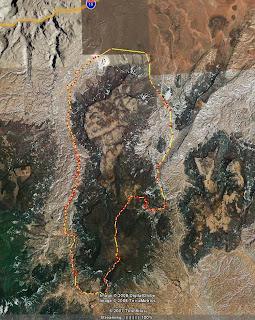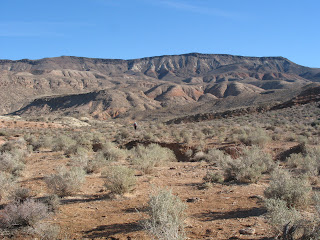 There are many beautiful places on this earth that cast a magic spell on some of us. We find ourselves returning again and again to relive those special feeling that we have experienced in the past. For me one of these places is Cerro Piuquencillo, a 13,200 ft. peak nestled in the Andes Mountains of Central Chile.I was introduced to this place by a seasoned Chilean mountain climber and old timer, Edison Sandoval, in 1979. I thank him for introducing me to the mountains of Central Chile. For many years I spent most of my annual leave climbing peaks near Santiago. Now that I have reached the golden years I limit myself to backpacking and trekking.
There are many beautiful places on this earth that cast a magic spell on some of us. We find ourselves returning again and again to relive those special feeling that we have experienced in the past. For me one of these places is Cerro Piuquencillo, a 13,200 ft. peak nestled in the Andes Mountains of Central Chile.I was introduced to this place by a seasoned Chilean mountain climber and old timer, Edison Sandoval, in 1979. I thank him for introducing me to the mountains of Central Chile. For many years I spent most of my annual leave climbing peaks near Santiago. Now that I have reached the golden years I limit myself to backpacking and trekking.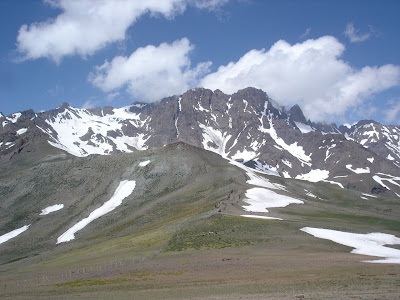 Getting there is all part of the fun.
Getting there is all part of the fun. Cerro Piuquencillo is approximately nine miles east of Lagunillas, a small ski resort in the Cajón del Maipo. To get there from Santiago I would recommend taking local inexpensive public transportation (metro and bus) to the town of San Jose de Maipo and hike from there. Follow an unpaved road to Lagunillas (about 10.5 mi.). One starts out at an elevation of 3200 ft. (San Jose) and ascends to 7400 ft. (Lagunillas). From Lagunillas follow a trail mostly used by arrieros to move cattle to summer pastures. In general it follows the ridge that separates the two drainage sheds until you get to the base of Cerro Piuquencillo (elevation 10,000 ft.). The base is a cirque created by ancient glaciation. This is an excellent place to make camp prior to making an ascent to the top or, if you like, just exploring the surrounding area. Good water is readily available at this location.

During the summer I would recommend hiking the San Jose - Lagunillas leg during the early morning or late afternoon as it tends to be hot. Keep an eye out for the trail that cuts though the many switchbacks. This will cut off considerable distance. Be sure to carry plenty of water. There is a spring a couple of miles below Lagunillas and another about a half mile above. However, if you miss them there will be no water until you get to the base of Piuquencillo. During the first leg one often sees cottontails , California quail and many other small species of birds.
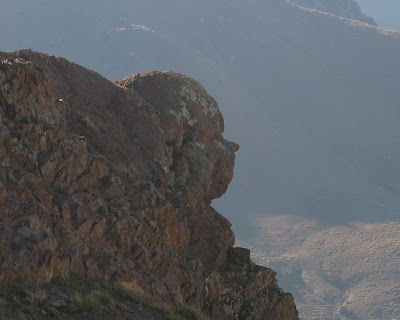
The Lagunillas - Piuquencillo leg is a real treat. About an hour up the trail one passes the profile of a face in the rock. I'm sure it has a name but since I don't know what it is I have named it "Cariguagua" meaning baby face. A friend calls it "El Alcalde" meaning the mayor. It is more than 12 feet high from base of chin to top of forehead.
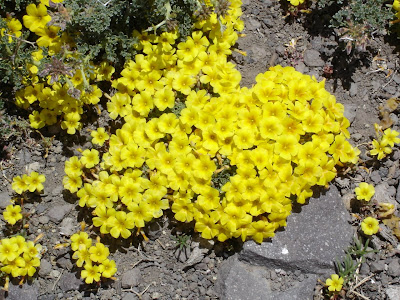
My favorite time of the year to do this hike is in late December or early January. This is when the wild flowers are out in all of their glory and splendor. There are dozens of varieties, some are very small and minute while others are much larger, each having its own particular color, display and beauty.
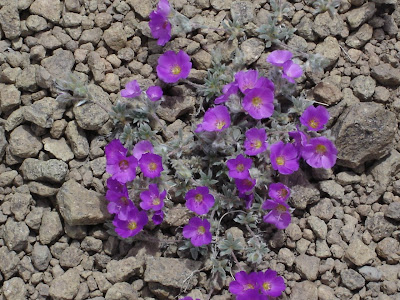
There are yellow meadows, white meadows, and burgundy meadows. They bloom soon after the snow melt to take advantage of the residual moisture. The beholding of such is a pleasure to the eye. I'm sure this would be a botanist's paradise.

Another reason I enjoy this hike is that inevitably one has the thrill of seeing the majestic Andean condor as it soars over the ridges and down the mountain valleys. They are easily identified by their size, the white feathers on the back of their wings and the white collar.
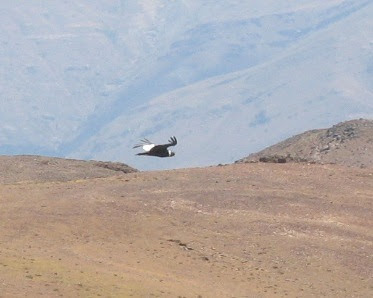 According an official web site "The Andean Condor has a body length of 43 - 51 inches and an 11-foot wingspan. The smaller female weighs 17 1/2 - 24 pounds while the larger male weighs 24 - 33 pounds" (www.peregrinefund.org).
According an official web site "The Andean Condor has a body length of 43 - 51 inches and an 11-foot wingspan. The smaller female weighs 17 1/2 - 24 pounds while the larger male weighs 24 - 33 pounds" (www.peregrinefund.org). I have been hiking this route for almost thirty years and I can't remember a trip that I have not seen a condor. If one is observant he is likely to see a dozen or more. The rising air currents above the ridges are ideal for the condor to gain altitude. They glide in from across the valley in search of an updraft. Once over the ridge they will continue to circle until they achieve the desired altitude. Then they glide off to another destination. They prefer roosting and nesting on high mountain ledges in the Andes. Piuquencillo provides such a place.
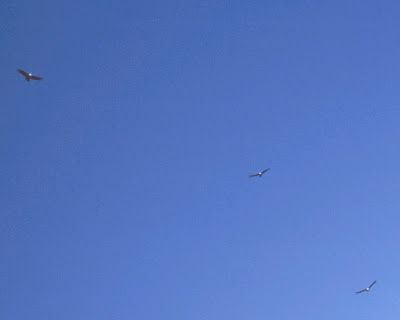
During one excursion years ago having summited with a friend, Liam O'Brien, we laid motionless on the ground observing a condor in the vicinity. We laid there with the hope of attracting it for a closer view. Soon it was joined by two others, all circling over head. With each pass they would come a little closer until it appeared that one was going to land on us. Due to its enormous size my survival instincts caused me to raise my leg. With this action all three departed. This really made our day. In my many years hiking in the Andes this was my closest encounter with a condor. I have no explanation for what had transpired however it was possible due to a small dog that had tagged along with us from Lagunillas. It may have attracted the condor as it also laid motionless.This whole area excluding the peaks is summer pasture for cattle, horses and goats. It is not uncommon to meet an arriero (Chilean cowboy) on his horse taking care of the livestock. One may also see viscacha, a South American rodent about the size of a very large rabbit with a long bushy tail. They are mostly nocturnal and can only be seen at day break before retreating to their den in the rocks.
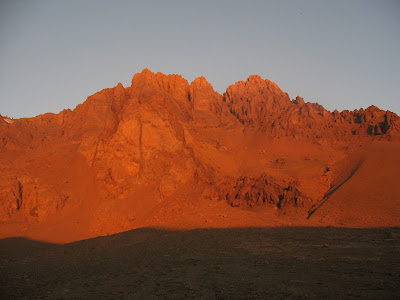
Camping in the cirque is a pleasure. First, there is an abundance of delicious cold spring water. Second, the view is spectacular. One is surrounded by rugged, colorful, sheer rock cliffs dropping thousands of feet to the cirque floor. In the evening as the sun slips over the western range of mountains, the surrounding peaks take on an alpine glow. The colors change from a bright crimson orange to a pastel purple as the sun disappears and night begins to fall. Weather permitting, sleeping under the stars on a moonless night is a sight to behold. This is the night sky that I remember as a child in the Sierra Madre Mountains of Northern Chihuahua. However, instead of the Big Dipper and Polaris one sees the Southern Cross and other stars of the southern sky. The view is magnificent and the stars are without number. An occasional satellite is visible as it reflects light from the departed sun as it journeys through the night sky. The color of the early morning sky begins with an indigo blue which silhouettes the black of the mountain peaks. Gradually the sky takes on warmer tones as day begins to break.

Summiting Piuquencillo is an all day affair. The route that I would take was up the loose stuff where you take two steps forward and slide one and a half back. This is slow and tiring but if you stay with it you will eventually get there.

Snow and ice fields are a welcome change. Crampons and an ice ax are very handy and a must in the steep areas. Rock outcrops also make climbing easier. The ice field were once very large (1979) and remained throughout the year. However, over the years they have continued to shrink and now will often completely disappears at the end of the summer. This is just another fatality of global warming.
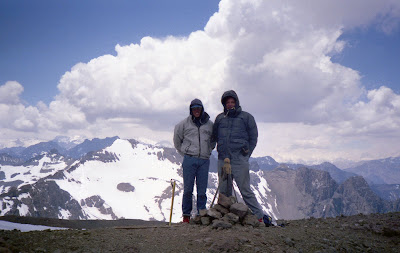
The view from the top, needless to say, is superb and exhilarating. The lofty peaks of the Central Andes are all in plain view. Each with countless stories of mountain climbers who over the years have attempted to reach their summits.
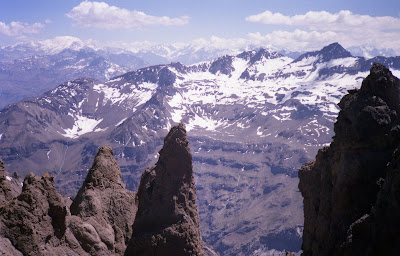
I found the ice formations (penitentes) near the summit very interest and strange. I don't understand the forces behind the creation of these ice pinnacles but they are a sight to see. The forces of nature are at there best. I have seen similar formations on other peaks but none like these.

At the head of the cirque (north end) there is a boulder strewn landscape. These boulders are twenty to thirty feet high and may have been left there when the glacier melted or maybe they are a result of seismic activity. If that is the case I would not want to be camping around them during an earthquake.
 The Boots.
The Boots. I had an expensive pair of swiss mountain climbing boots that had served me very well on many climbs in the Andes. They had summited Cerro San Ramón more times than I can count, Cerro Piuquencillo several times, Cerro El Plomo several times, and Volcán San José twice. When they wore out I felt that they deserved a dignified internment. So in 1994 while climbing Cerro Piuquencillo I selected a spot at the base on one of the gigantic boulders at the head of the cirque to bury them under some rocks. Fourteen years later (2008) I find that they are still there and in fairly good condition.

Will I return? Yes, you can count on it, just as long as these old bones will get me there.
 It was in 1983 that the government moved us to
It was in 1983 that the government moved us to 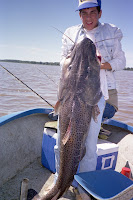 Over the years I began to believe that if I should even as much as touch the bait, the fish would be repelled. I had heard and read about many great fishing trips but had never been part of one. So I said jokingly, “OK you guys, your supervisor’s appraisal is on the line. Your going to have to take me on one of these trips that fisherman dream about.” An so it was, I went with them and some other friends from the embassy for a two day fishing trip during Holy Week of 1985. The fishing was beyond my maddest dreams. It was real. There was a place where the fishing was so great that any fish weighing less than 5 kgs. (11 lbs.) was thrown back. We had a grand time and this was the beginning of several years of fishing adventure.
Over the years I began to believe that if I should even as much as touch the bait, the fish would be repelled. I had heard and read about many great fishing trips but had never been part of one. So I said jokingly, “OK you guys, your supervisor’s appraisal is on the line. Your going to have to take me on one of these trips that fisherman dream about.” An so it was, I went with them and some other friends from the embassy for a two day fishing trip during Holy Week of 1985. The fishing was beyond my maddest dreams. It was real. There was a place where the fishing was so great that any fish weighing less than 5 kgs. (11 lbs.) was thrown back. We had a grand time and this was the beginning of several years of fishing adventure.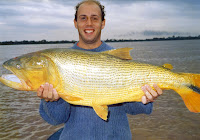 It was Jeff that made the first move to solve the problem. He bought a used outboard motor. With such he could rent a boat without the guide. By this time we had been with a guide enough time to know where the submerged rocks were and where the best fishing was. The motor was a ‘lemon’. On the second or third trip it sheered the drive shaft. We got a break from Peter Podest from our
It was Jeff that made the first move to solve the problem. He bought a used outboard motor. With such he could rent a boat without the guide. By this time we had been with a guide enough time to know where the submerged rocks were and where the best fishing was. The motor was a ‘lemon’. On the second or third trip it sheered the drive shaft. We got a break from Peter Podest from our 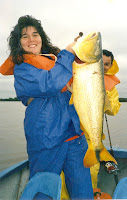 Ours was white with blue trim and we named it Yankee.
Ours was white with blue trim and we named it Yankee.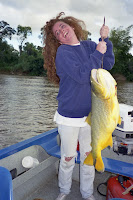
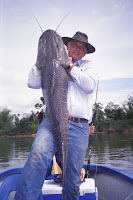 We said that we were fine and that we would soon be on our way again. So they departed. There was still no mention of a race. By the time we had gathered up all of our bait they were almost out of sight. We went full throttle again and shortly were passing them again. We proceeded on to our favorite fishing spot and did not see them again until some time later. When we saw each other again we had both been fishing for some while. We had caught a couple of nice fish and they may have had one or two. We both avoided the subject of the unmentionable, the results of the unofficial race. We talked about the fishing, the beautiful day, what we brought for lunch, and other small talk. Finally, Jeff said, “We’ve got a problem with our motor”. And I playing the innocent responded, “What do you mean?” He said, “You know when you passed us up this morning I yelled to Sam, “give it all its got” and Sam said, “I’m giving it all its got” and you know you passed us up like we were standing still. I guess we will have to take our motor back and have it checked out.” And I showing my deepest sympathy said, “I am very sorry to hear that. I hope that it is nothing serious.” I was enjoying every minute of their stress and watching them react to this humbling experience.
We said that we were fine and that we would soon be on our way again. So they departed. There was still no mention of a race. By the time we had gathered up all of our bait they were almost out of sight. We went full throttle again and shortly were passing them again. We proceeded on to our favorite fishing spot and did not see them again until some time later. When we saw each other again we had both been fishing for some while. We had caught a couple of nice fish and they may have had one or two. We both avoided the subject of the unmentionable, the results of the unofficial race. We talked about the fishing, the beautiful day, what we brought for lunch, and other small talk. Finally, Jeff said, “We’ve got a problem with our motor”. And I playing the innocent responded, “What do you mean?” He said, “You know when you passed us up this morning I yelled to Sam, “give it all its got” and Sam said, “I’m giving it all its got” and you know you passed us up like we were standing still. I guess we will have to take our motor back and have it checked out.” And I showing my deepest sympathy said, “I am very sorry to hear that. I hope that it is nothing serious.” I was enjoying every minute of their stress and watching them react to this humbling experience. 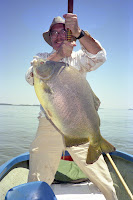 I think that Michael was enjoying it as much as I. I, also, wanted them to stew over this for a while at least until JJ got back.
I think that Michael was enjoying it as much as I. I, also, wanted them to stew over this for a while at least until JJ got back.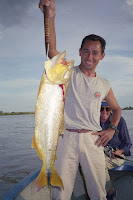 “I guess so, he will find out sooner or later anyway.” So we told him the details from the beginning to the end. JJ and I had a big laugh but Jeff appeared mortally wounded. How did we dare humiliate him in such a conspiring way? We didn’t play fair.
“I guess so, he will find out sooner or later anyway.” So we told him the details from the beginning to the end. JJ and I had a big laugh but Jeff appeared mortally wounded. How did we dare humiliate him in such a conspiring way? We didn’t play fair.












